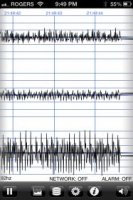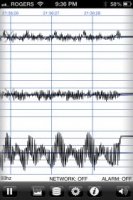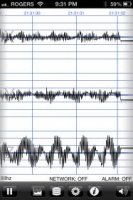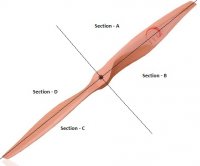you are entirely relying on the accuracy of the threads to make that work.
Before removing or disassembling the motors I screwed the tube onto the top of each motor shaft and gave them a spin. The tube had no wobble to it at all. Stood straight up.
I can even see in this video the wobble is so much that I guarantee you the bell housing is not that off, its the tube making it show that way.
One of the four motors was perfect as-is, needing no balancing at all. This motor was way out though. True, you can clearly see in this video how much the bell housing wobbles. If that was caused by the tube not being screwed on square then you should see a similar amount of wobble at the joint between the tube and the motor shaft. Hold your screen cursor on the video at the edge of the tube (not the keyed portion of the motor shaft, eh) and watch to see how little it moves up and down.
This motor's bell housing is way out of whack.
In short, I would NOT rely on this method.
I don't own an iPhone, and have no access to the iSeismometer app. I knew for certain that the motors were out of balance because, with the props removed, the Phantom would dance the jitterbug all across the table when the motors were run.
I opened up the shell and disconnected the ESCs three at a time from the NAZA controller so I could run each motor individually. Then I balanced them by trial and error, relying just on the sound and feel for whether the vibration improved or got worse. That helped, but it wasn't perfect. Running all four motors together again would be smooth at half throttle, but the Phantom still buzzed around the table at full throttle.
Doing the balancing this way, with the tube on a Du-Bro balancer, for sure it's only a static balance -- not dynamic. But, there's no guesswork involved as to where to stick the balancing tape. It's just a question of how much tape to apply.
I wish I had taken a video of the Phantom buzzing around on the table before I balanced the motors. But, after balancing, the difference was amazing.
In the last shot where I'm running the motors, the tube is lying loose on the table, just to the left of my hands. There isn't even enough vibration left to get that tube rolling on the table.
It's maybe not a perfect method, but it's a whole lot simpler and cheaper than buying an iPhone.




